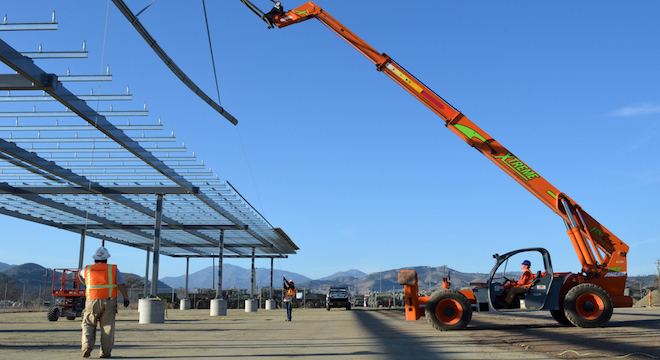TINA CASEY
The U.S. Army Corps of Engineers (USACE) has been involved in some massive projects over the years, and it is poised to outdo itself, this time when it comes to renewable energy construction.
On February 24, the agency announced a draft request for proposals (RFPs) for “potentially the largest contract ever awarded” by the Corps’s Huntsville Center in Alabama. The draft calls for $7 billion in energy projects that produce power not from oil or gas but from solar, wind, geothermal, or biomass.
The projects the USACE envisions would ideally be “large scale” power generation projects that could appear on any federal property throughout the country. The agency will award up to $7 billion over 10 years, according to the draft, soliciting bids from all types of businesses, large and small.
The announcement put some muscle behind President Obama’s weekly address the following morning, in which he reiterated his call for an “all-of-the-above” energy strategy that develops wind, solar, and other renewable energy sources.
It also bears out a Pew Charitable Trusts study released in September 2011, which noted a rapid increase in clean energy projects by the Department of Defense and predicted that its clean energy investments would top $10 billion annually by 2030.
The new projects would not represent an outlay of $7 billion by taxpayers, though. They will be constructed on federal property by private investors, using the now-familiar mechanism of power purchase agreements, according to the announcement from the USACE:
“It is the intent of the government only to purchase the energy that is produced, and not to acquire any generation assets. The contractors will finance, design, build, operate, own and maintain the energy plants. The government will contract to purchase the power for up to 30 years in accordance with the terms and conditions stipulated in site or project specific agreements.”
Power purchase agreements are commonly used in the solar energy industry to provide renewable energy purchasers with a financing mechanism for on-site energy generation. Rather than owning the means of generation, the owner simply provides the real estate for a renewable energy installation in exchange for an agreement to purchase that power, generally at a rate lower than conventional electricity.
For the Department of Defense, power purchase agreements provide a way to accelerate the pace toward its renewable energy goals without running into budgetary obstacles or, for that matter, opposition from members of Congress who are opposed to federal investment in alternative energy.
The Department’s goal is to produce or consume 25 percent of its energy from renewable sources by the year 2025, under a series of executive orders and federal laws dating back to the Bush administration.
As the President noted, “we just can’t drill our way to lower gas prices,” and the price of fuel is one important factor in DoD’s focus on renewable energy.
Equally as important is reliability of supply. As outlined in the Army’s Net Zero initiative, part of the overall energy goal is to develop energy sources that can be harvested on or close by their point of use.
Recent years have seen an increasing number of both small and large scale alternative energy installations at DoD facilities, notably solar. However, until last year these were generally administered on a piecemeal basis.
The Corps of Engineers aims to step up the pace by leveraging its long experience in administering large scale energy projects.
The new contract will be in support of the Energy Initiatives Task Force, which the Army launched last fall to serve as a “one stop shop” for getting more private sector investment into large-scale Army renewable energy projects more quickly, by lifting the burden of administering those projects from individual base commanders.
EITF is also charged with vetting and developing emerging new alternative energy technologies.









